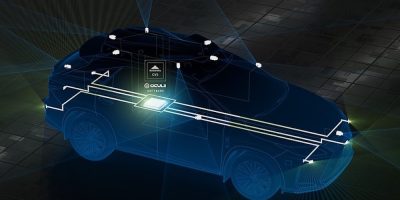4D imaging radar architecture drives autonomous mobility, says Ambarella
Ambarella has introduced what it claims to be the world’s first centralised 4D imaging radar architecture which allows both central processing of raw radar data and deep, low-level fusion with other sensor inputs (including cameras, lidar and ultrasonics). Thie result is greater environmental perception and safer path planning in AI-based ADAS and L2+ to L5 autonomous driving systems or autonomous robotics, said the company.
Ambarella has used its Oculii radar technology which includes AI software algorithms.
By optimising the Oculii algorithms for its CV3 AI domain controller SoC family and adding specific radar signal processing acceleration, the architecture dynamically adapts radar waveforms to its surroundings to provide high angular resolution of 0.5 degrees and a dense point cloud up to 10s of thousands of points per frame, with a long detection range up to 500+ meters.
The CV3’s AI performance per Watt offers the compute and memory capacity needed to achieve high radar density, range and sensitivity, said the company. A single CV3 can provide high performance, real time processing for perception, low level sensor fusion and path planning, centrally and simultaneously, within autonomous vehicles and robots.
This is all achieved with fewer antenna MIMO channels than competing 4D imaging radars, said Ambarella, which reduces the data bandwidth and results in “significantly lower power consumption” said the company.
The data sets of competing 4D imaging radar technologies are too large to transport and process centrally. They generate multiple Tbits per second of data per module, while consuming more than 20W of power per radar module, due to thousands of MIMO antennas used by each module to provide the high angular resolution required for 4D imaging radar. This figure is multiplied across a vehicle’s six or more radar modules, making central processing impractical for other radar technologies, which must process radar data across thousands of antennas.
The data sets of competing 4D imaging radar technologies are too large to transport and process centrally. They generate multiple Tbits per second of data per module, while consuming more than 20W of power per radar module, due to thousands of MIMO antennas used by each module to provide the high angular resolution required for 4D imaging radar. This figure is multiplied across a vehicle’s six or more radar modules, making central processing impractical for other radar technologies, explained Ambarella.
Applying AI software to dynamically adapt the radar waveforms generated with existing monolithic microwave integrated circuit (MMIC) devices and using AI sparsification to create virtual antennas, Oculii technology reduces the antenna array for each processor-less MMIC radar head in this new architecture to six transmit x eight receive.
While the number of MMICs is drastically reduced, a high 0.5 degrees of joint azimuth and elevation angular resolution is achieved, reported Ambarella. The centralised architecture consumes significantly less power, at the maximum duty cycle, and reduces the bandwidth for data transport by a factor of six. It also eliminates the need for pre-filtered, edge processing which can result in loss of sensor information.
Additional benefits of the centralised architecture include easier over the air (OTA) software updates. Instead of individually updating each radar module’s processor after determining the processor and OS being used in each, the Ambarella architecture requires a single OTA update to the CV3 SoC and aggregated across all of the system’s radar heads. These radar heads eliminate the need for a processor, which reduces bill of material costs as well as costs in the event of damage from an accident (most radars are located behind the vehicle’s bumper). Additionally, many of the edge-processor radar modules deployed today never receive software updates because of this software complexity.
The centralised architecture will be demonstrated at Ambarella’s invitation-only event taking place during CES in Las Vegas in January. For sampling and evaluation information, contact Ambarella.




